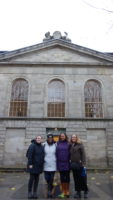 I am very thankful that modern life lets us travel to Europe quickly and affordably. International commercial air travel has been around less than one hundred years, and jet travel only started in 1958. Not too long ago, Europe would have been a month-long proposition, and very expensive. Now we can afford to go two or three times per year, and going for a week makes sense because getting here is so quick. It’s still a marvel, and I am grateful.
I am very thankful that modern life lets us travel to Europe quickly and affordably. International commercial air travel has been around less than one hundred years, and jet travel only started in 1958. Not too long ago, Europe would have been a month-long proposition, and very expensive. Now we can afford to go two or three times per year, and going for a week makes sense because getting here is so quick. It’s still a marvel, and I am grateful.
We took an Uber (taxi) today to start out because we were going to a fairly far-flung sight – Kilmainham Gaol. Kilmainham is a jail that was active from the 1700s to 1923, and it mostly was used to house petty criminals, but five percent of the prisoners held there were political prisoners, and so it has remained an important Irish site.
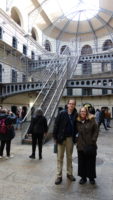 Meredith and I had been to Kilmainham back in 2000 or so, and I jokingly told our driver that I supposed lots of things had changed. He said, in all seriousness, that they had. It turns out the next-door courthouse that was active in 2000 closed down around 2008, and now houses information about the court, and is where tours meet. Between the jail and courthouse, a museum has been added, which focuses on the events of the Easter Rising of 1916, which led to Irish Independence in 1922, which led to the Irish Civil War in 1923. While most tourist tours dump you out in a gift shop at the end of the tour, Kilmainham tours end at the museum, so you have an excellent context for the displays in the museum.
Meredith and I had been to Kilmainham back in 2000 or so, and I jokingly told our driver that I supposed lots of things had changed. He said, in all seriousness, that they had. It turns out the next-door courthouse that was active in 2000 closed down around 2008, and now houses information about the court, and is where tours meet. Between the jail and courthouse, a museum has been added, which focuses on the events of the Easter Rising of 1916, which led to Irish Independence in 1922, which led to the Irish Civil War in 1923. While most tourist tours dump you out in a gift shop at the end of the tour, Kilmainham tours end at the museum, so you have an excellent context for the displays in the museum.
Kilmainham had thousands of prisoners over the years, especially during the Famine of 1845-1850, when some thought it better to be in jail than to starve to death. But the most famous prisoners were those who were held in Kilmainham for their role in the Easter Uprising of 1916. The rebellion was badly outnumbered (about two thousand versus twenty thousand), and the leaders were caught and held and executed, except for one woman who was second in command of a brigade, who was released after a year. One man married the night before he was shot and was allowed to spend ten minutes with his new bride; they held hands and never saw each other again. One man was so badly wounded he couldn’t stand for the firing squad, so they shot him while he sat in a chair. While the rebellion didn’t have popular support, the public outrage at the execution of fourteen men enraged the public and led to strong Irish nationalism, which finally resulted in a treaty for independence in 1922. The terms of the treaty were controversial, so that sparked a civil war that lasted about a year, and some members of the anti-treaty group were held in Kilmainham, except this time it was fellow Irish guarding them. It’s a complex and important place for Irish history.
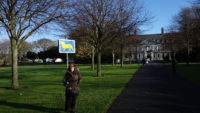 After seeing the jail, we walked through the pretty grounds of the modern art museum and the adjacent hospital grounds. It was a pretty late morning, and we took our time. We took another Uber back to the hotel, and then went nearby to Christ Church Cathedral to tour it.
After seeing the jail, we walked through the pretty grounds of the modern art museum and the adjacent hospital grounds. It was a pretty late morning, and we took our time. We took another Uber back to the hotel, and then went nearby to Christ Church Cathedral to tour it.
Christ Church is the oldest surviving building in Dublin, with the crypt dating back eight hundred years or more. It’s an interesting building to me because it is the only cathedral I know of where the roof collapsed (I assume because of lack of maintenance, but I don’t know). The collapse damaged one wall badly, and a “temporary” wall was put up that lasted three hundred years, until the 1800s, when a rich whiskey distiller donated about (in today’s money) thirty million dollars to repair the building. The wall that stayed up was kept in place, but you can see that it leans out about a foot and a half. Those sorts of structural things interest me.
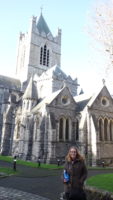 We ate lunch, and then split up. Shelby went to tour a whiskey museum, while Regina and Neuf went down to the river to see Ha’penny Bridge and then wander around the Temple Bar area, which is a neighborhood of bars and restaurants that is happening in a tourist-intensive sort of way. Mer and I walked twenty minutes over to The Little Museum of Dublin.
We ate lunch, and then split up. Shelby went to tour a whiskey museum, while Regina and Neuf went down to the river to see Ha’penny Bridge and then wander around the Temple Bar area, which is a neighborhood of bars and restaurants that is happening in a tourist-intensive sort of way. Mer and I walked twenty minutes over to The Little Museum of Dublin.
The Little Museum of Dublin was a bit of a mystery to me, but it was starting to rain, and I knew we only had a couple of hours if we wanted to get back to St. Patrick’s Cathedral in time for the evensong service. The Little Museum turned out to be housed in a Georgian house of a type that was common in Dublin in Victorian times, and it had two rooms filled with Dublin memorabilia. A guide joined us and gave us a thirty-minute overview of Dublin’s history, using the pictures on the wall as visual aids. Our guide was energetic and loud and had a corny sense of humor, and she was Greek (but spoke excellent English). Dublin is more cosmopolitan than I remember – as far as I can tell, we’ve not had anyone Irish wait on us in any service capacity in a hotel or restaurant, and not always in the museums, since we’ve been in Dublin. But our guide was fun, and it was a good overview of many of the things we had learned at Kilmainham during the morning.
We did make it back to St. Patrick’s Cathedral for evensong. It was a lovely service, lasting about thirty minutes. The excellent choir did all of the singing, and was largely made up of school-aged girls, although it did have a few older men for the bass parts. Shelby, Regina, and Neuf went instead to the 6:00 evensong at Christ Church, which they said was very beautiful.
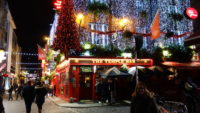 We finished the evening looking for food. It took awhile to find a restaurant that had seating, but we found a BBQ place in Temple Bar that fed us very well, which we followed up with waffles and crepes at a gelato stand. Not a traditional Thanksgiving meal, but the gratitude was still genuine.
We finished the evening looking for food. It took awhile to find a restaurant that had seating, but we found a BBQ place in Temple Bar that fed us very well, which we followed up with waffles and crepes at a gelato stand. Not a traditional Thanksgiving meal, but the gratitude was still genuine.